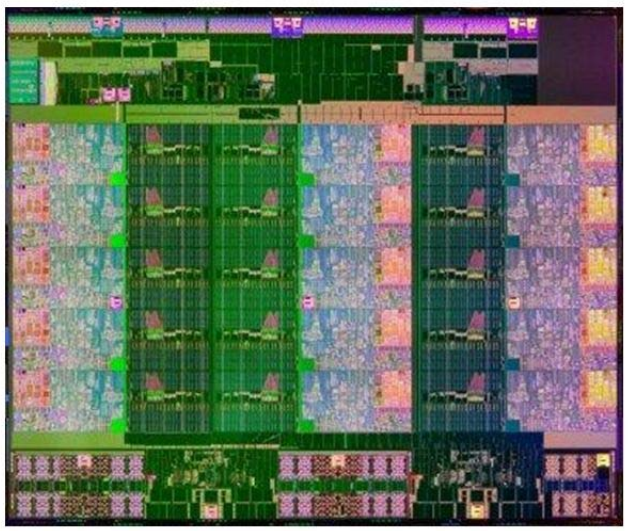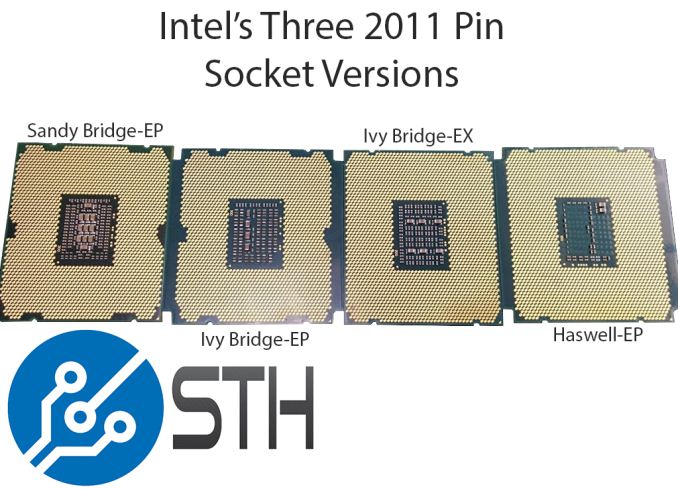Intel’s Three Versions of Socket 2011, Not Compatible
by Ian Cutress on February 20, 2014 9:45 AM EST- Posted in
- CPUs
- Intel
- Xeon
- LGA2011
- Ivy Bridge EX

With our recent discussion regarding Intel’s launch of the 15-core Xeon E7 v2 ‘IvyTown’ processors, thoughts for a lot of high end consumers focused on the underlying hardware for these 4P and 8P systems that would be entering the market. Previously with high end systems there has been a disjunct between the sockets used for the mainstream 1P and 2P processors (-E and -EP) compared to the higher end 4P/8P models (-EX). For example:
With Nehalem/Westmere, the single socket Bloomfield Xeons were LGA 1366.
With Nehalem-EP/Westmere-EP, the dual socket Gainstown Xeons were also LGA 1366.
With Nehalem-EX/Westmere-EX, the quad/octo socket Beckton Xeons were LGA 1567.
With Sandy Bridge-E/Ivy Bridge-E, the single socket Xeons are LGA 2011.
With Sandy Bridge-EN/Ivy Bridge-EN, the single/dual socket Xeons are LGA1356
With Sandy Bridge-EP/Ivy Bridge-EP, the dual socket Xeons are LGA 2011.
With Ivy Bridge-EX, the quad/octo socket Xeons are also LGA 2011, but different.
Reported images of Haswell-EP Xeons also point to LGA 2011, but different again.
Back at ISSCC, when we reported about the talk around the new IvyTown based processors, we lifted the following line from the official documentation:
- “The processor supports two 2011-land, 40-mil pitch organic flip-chip LGA package options”
This produced speculation to whether the processor package for EX would be the same as EP, despite a reconfigured memory controller, additional QPI links and a different pin layout. Given at the time we were under NDA we could not mention they were different, but some investigative work from Patrick at ServeTheHome answers a lot of questions.
Simply put, Ivy Bridge-EP, Ivy Bridge-EX and Haswell-EP all have LGA2011 designations (officially FCLGA2011, for flip-chips), but have different physical mountings in the socket:
Despite the contact patches/‘wings’ on Ivy Bridge-EP, it will fit in the Sandy Bridge-EP socket – the issue is more the pins on Ivy Bridge-EX and Haswell-EP, where on the left and right it is more ‘filled in’, as well as at the corners. The notches for the processors (the indents on the top and bottom) are also different, moving to Ivy Bridge-EX.
The Ivy Bridge-EX and Haswell-EP processors look very similar from these images, despite the extra wings on the Haswell-EP. The key here is the bottom right of the two processors, and count the number of pins between the notch and the edge – Ivy Bridge-EX has four, Haswell-EP has six.
All in all, this may not much of anything – users spending thousands on processors should be making sure that the motherboards they buy have the processor they want listed in the QVL (Qualified Vendor’s List). My concern might be users thinking they can drop a Haswell-EP Xeon into an Ivy Bridge-E, and then trying to force it when it might not fit. Back in previous eras (socket 775 comes to mind) this was an even bigger issue – the processors might fit, but the processors that a motherboard could take was determined by the chipset used by the motherboard manufacturer and the QVL. At least this way the CPUs will not physically fit, but it is something that confuses the situation – it might be worth doing some clever renaming (LGA2011-EX, LGA2011-H), at least from an editorial point of view for the future.
Source: ServeTheHome











47 Comments
View All Comments
FieryUP - Thursday, February 20, 2014 - link
AFAIK Haswell-E/EP socket is designated (by Intel) as LGA2011-3, and SNB-E/EP/IVB-E/EP socket is LGA2011-0. If IVB-EX would have LGA2011-2, then it would just be quite logical, although I'm not sure what happened to LGA2011-1 then :)repoman27 - Thursday, February 20, 2014 - link
Yep, you got it. The original SNB-E/IVB-E socket was referred to by Intel as "LGA2011-0" or "Socket R" and the HSW-E variant as "LGA2011-3" or "Socket R3". More details here: http://vr-zone.com/articles/intel-core-i7-ivy-brid...Somewhat oddly, the Intel parlance for the Xeon E7 v2 socket seems to be "LGA 2011" or "Socket R1".
Berzemus - Thursday, February 20, 2014 - link
Just check the supported CPU list at your motherboard's vendor's website. The required BIOS version is a bonus.As for AMD: FX-9000 series 220W TDP made them incompatible with (virtually ?) all previous AM3+ motherboards.
TiGr1982 - Thursday, February 20, 2014 - link
In case of FX-9000 it's not an electrical/logical compatibility issue, but a TDP issue (for M/B - specific high requirements for CPU socket power delivery).There is nothing totally new here with FX-9000 - this kind of issue existed several years ago for Phenom I X4 / II X4 140W models - these particular models were also not supported by a bunch of cheaper/simpler M/Bs.
TiGr1982 - Thursday, February 20, 2014 - link
Seems to be a non-issue at all, because:1) professional IT staff is dealing with Xeons, so by default, being professionals, this staff knows what is for what.
2) enthusiasts are dealing with desktop LGA2011 CPU's. These guys, being enthusiasts/prosumers, also happen to read the web and to know what is for what in advance - before actually buying the stuff.
So, it's just an interesting engineering curiosity, but not a problem at all.
maecenas - Thursday, February 20, 2014 - link
Not a problem until someone messes up and ruins chip and/or board. You have to admit this is a ridiculous system. At the very least they could call them 20011a, 2011b, etc.TiGr1982 - Thursday, February 20, 2014 - link
Yes, I admit :)For the consumer/end users desktop segment, there still should be some designation differing current LGA2011 (Sandy Bridge-E/Ivy Bridge-E) vs future LGA2011 (Haswell-E).
There probably will be one (like 2011-3 or something for the new desktop LGA2011),
when Haswell-E for desktop will be released (rumours telling in Q3 this year).
repoman27 - Thursday, February 20, 2014 - link
They do have names (see the above comment by FieryUp). Granted, they're not necessarily good names, but it is Intel we're talking about here. They are also notched differently so the chips cannot be inserted into an inappropriate socket/system without the use of considerable force.TiGr1982 - Thursday, February 20, 2014 - link
Of, course they do have internal names inside Intel (say, 1156 is H1, 1155 is H2, and 1150 is H3). The question is how the new desktop LGA 2011 (Socket R3) will be named consumerwise - what will be written on the CPU box at retail :)LGA2011-3, probablly?
Assimilator87 - Thursday, February 20, 2014 - link
Well hopefully, someone spending $6500 on a processor will check board compatibility beforehand.